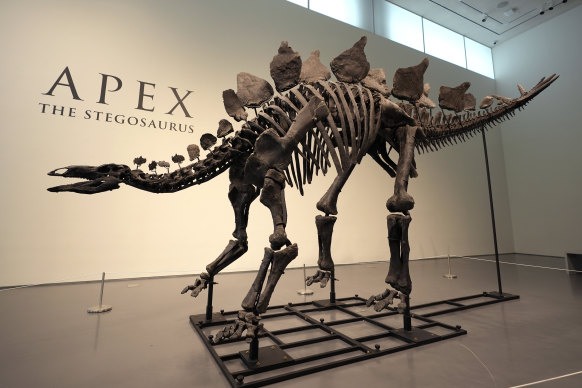Opinion
$67 million stegosaurus upends the dinosaur hierarchy
By Chris Bryant
What’s the point of a $US42 billion ($63 billion) fortune if you can’t occasionally drop a fraction of it on an awe-inspiring dinosaur fossil?
On Wednesday, a Stegosaurus nicknamed “Apex” sold at Sotheby’s for almost $US45 million, around nine times the auction house’s presale estimate, making it the most valuable fossil ever sold at an auction. The identity of the deep-pocketed mystery buyer soon emerged: Ken Griffin, the chief executive officer and founder of hedge fund Citadel. “Apex was born in America and is going to stay in America!” he said.

‘Apex’ the Stegosaurus skeleton at Sotheby’s New York in New York.Credit: AP
The enormous price is certain to spark complaints from palaeontologists that our natural history is being privatised by the financial elite, but I’m far more relaxed: the profit motive should help unearth more amazing dinos.
Of course, it would be deeply uncool to keep one of these specimens hidden away in the atrium of your mega-mansion, but fortunately that isn’t what the buyer plans to do: the skeleton will be loaned to a US museum, the Wall Street Journal reported. That’s where dinosaurs belong, so on a rainy weekend they can be gazed at in wonder by kids and their parents.
One could argue the money would do more good if given directly to researchers, but this astonishing outlay is likely to further stoke the hunt for fossils. Unlike in many countries where dinosaur finds belong to the state and exports are banned, US landowners get to keep skeletons found on their property.
“The fossils that are being discovered are ones that are slowly being exposed due to erosion and weather events,” Cassandra Hatton, Sotheby’s science and historic artefacts specialist and the organiser of this week’s sale, told me last year. “You can either have a commercial palaeontologist carefully excavating these or you can lose them forever, take your pick.”
In this instance, the landowner happened to be a professional fossil hunter, a good advertisement for following your passion. Marketing a ranch in fossil-rich Colorado, where Apex was found in 2022, definitely just got easier for real estate agents.
More surprising is that Griffin paid $US45 million for a small-brained herbivore.
Although this is a relatively new market, there are a couple of rules of thumb in dinosaur investing. First, values vary according to the completeness of the skeleton and, second, how meticulously the discovery was documented — this one was around 70 per cent complete, which is very good.
Another is that the dinosaurs you could name as a kid or saw in Jurassic Park are worth the most. (People point the finger at Hollywood celebrities such as Nicolas Cage and Leonardo DiCaprio for sparking the collecting craze, but if you ask me, director Steven Spielberg and composer John Williams’ creativity was far more influential.)

Billionaire Ken Griffin, chief executive officer and founder of Citadel, and owner of ‘Apex’.Credit: Bloomberg
Within that select group, ferocious predators have tended to fetch the most money, which doubtless reflects that most buyers are men.
A stegosaurus’s dorsal plates certainly make for an impressive silhouette — there are several theories about what function they served — and calling this one Apex was a clever gambit. But its contemporaries probably feasted on ferns.
It could be a while, then, before someone pays this much for a stegosaurus again. That won’t bother Griffin, who’s fond of big-ticket purchases: in 2021, he spent $US43 million to acquire a first-edition copy of the US Constitution, which then went on display at the Crystal Bridges Museum of American Art in Bentonville, Arkansas.
He’s also a prolific donor: in addition to a $US16.5 million gift to Chicago’s Field Museum that transformed its T. Rex exhibit, he’s given to universities — and the Republican Party.
Much like today’s GOP, a $US45 million dinosaur isn’t to everyone’s taste. But I can’t wait to take my daughter to see it.
Bloomberg
The Business Briefing newsletter delivers major stories, exclusive coverage and expert opinion. Sign up to get it every weekday morning.